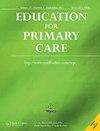The benefits of the expansion of the social prescribing student champion scheme into allied health professionals.
IF 1.5
Q3 PRIMARY HEALTH CARE
引用次数: 0
Abstract
Dear Editor, In 2020, a Twitter debate initiated the inclusion of allied healthcare professionals (AHPs) within the wellestablished Social Prescribing Student Champion Scheme [1]. The scheme gave medical students the opportunity to champion social prescribing (SP) by delivering peer-teaching [2]. Since the scheme was founded in 2017, the importance of SP has grown, with the potential contribution of AHPs further highlighted [3,4]. Therefore, the scheme expanded to include AHPs. Our role as leads for the medical and AHP branches of the scheme was to work together to develop a structure that met our different learning needs while successfully integrating the two branches of the scheme. This required more than a tokenistic insertion of 'and other healthcare professional students' into the scheme text. To truly integrate both ‘branches’ of the scheme, when we all have different professional applications of social prescribing, we needed to recognise what we all had in common as students – the shared purpose of making a positive difference for our patients. Although as students, we spend time developing our own professional identities, it was refreshing to remember ‘we have more in common than divides us’. Students were able to unite over this, and the new AHP champions were welcomed and integrated into the scheme by medical students. It was also helpful to recognise that under the umbrella of one profession, such as medicine, or professional cohort such as AHP, there remains enormous variation in roles and interests – a valuable lesson for future MDT working. As is common within MDT working, organising meetings was difficult, but working through the pandemic normalised virtual platforms and collaborative software. It also helped us to develop insights into the pressures and demands we all have during training, fostering respect for the time and effort spent developing our respective professional skills. One challenge was that our core team was not representative of all fourteen AHPs. However, conversations with respective professional bodies enabled the scheme to gain authenticity which facilitated approaching universities about the scheme, and furthered our MDT learning. The scheme’s structure did not directly incorporate the voluntary sector, which forms the backbone of social prescribing, and this provided a valuable lesson in the wider scope for collaboration beyond organisational boundaries, as is routinely required within clinical practice. Both branches had very different journeys in their inception, so while treating and evaluating the scheme as a whole, we also wanted to recognise the established track record of the medical scheme, and manage expectations of delivery of the AHP scheme in the first year. Therefore, collaboration rather than direct comparison was important. We are able to recognise each others’ relative successes and the cumulative impact of these for the scheme as a whole, which was more than the sum of its parts. Having since qualified, we now realise the power and flexibility we had as students to work on such a multidisciplinary project. Indeed, we encourage any students who are thinking of forming multidisciplinary projects to embrace the opportunity.将社会处方学生冠军计划扩展到专职医疗专业人员的好处。
本文章由计算机程序翻译,如有差异,请以英文原文为准。
求助全文
约1分钟内获得全文
求助全文
来源期刊

Education for Primary Care
PRIMARY HEALTH CARE-
CiteScore
2.30
自引率
15.40%
发文量
51
期刊介绍:
Education for Primary Care aims to reflect the best experience, expertise and innovative ideas in the development of undergraduate, postgraduate and continuing primary care education. The journal is UK based but welcomes contributions from all over the world. Readers will benefit from the broader perspectives on educational activities provided through the contributions of all health professionals, including general practitioners, nurses, midwives, health visitors, community nurses and managers. This sharing of experiences has the potential for enhancing healthcare delivery and for promoting interprofessional working.
 求助内容:
求助内容: 应助结果提醒方式:
应助结果提醒方式:


